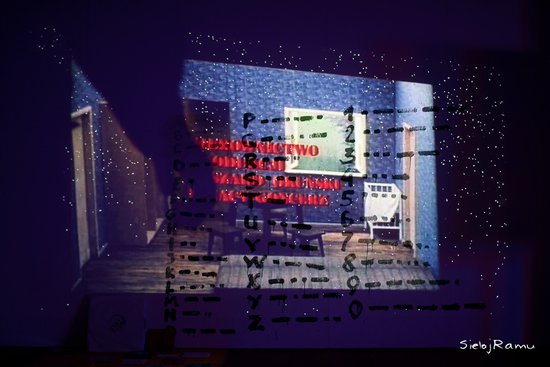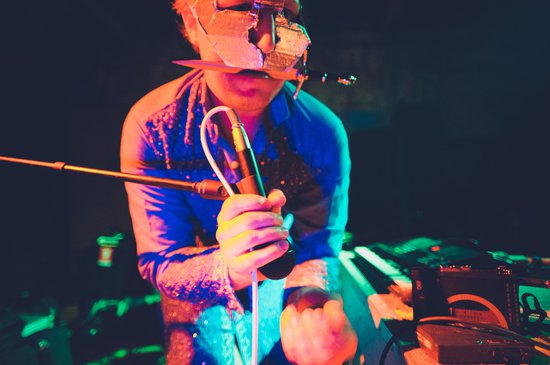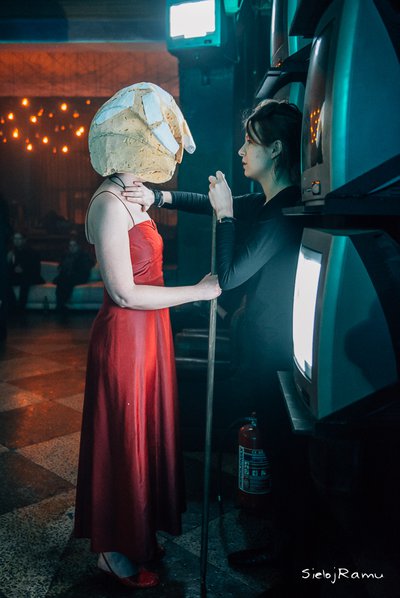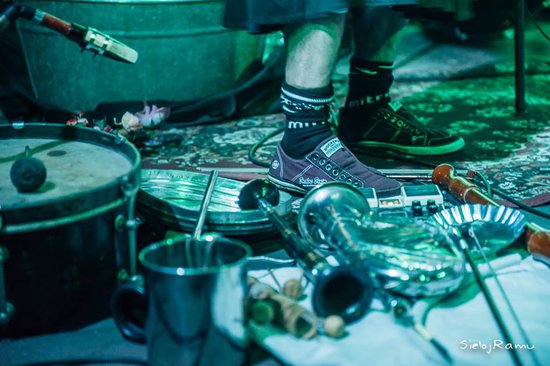Lithuanian Electronic / Experimental Music: An Inspirational Indefiniteness
- Nov. 3, 2015
There is another aspect that should be mentioned in describing the whole field of Lithuanian electronic / experimental music. And that is the socio-cultural dimension. A considerable part of its creators are active in the medium which is usually called the ‘underground’. And here, in turn, references to various subcultures begin to appear. This description, again, is more a matter of convention, emphasizing the fact that the musicians working in this field do not belong to the sphere of academic, institutional music. None of them harbours any concern on that count nor do they align themselves with any particular (sub)cultural tendency. The aforementioned stylistic free-thinking does not easily give itself to strict categorisation but seems to support this position (or on the contrary – the absence of a position). Moreover, acquaintanceship based on similar interests extends to the so-called ‘academic’ context. That is why it would be difficult to call the medium under discussion isolated.
In describing today’s electronic / experimental music scene, it should be noted that the critical mass in the whole field of this music is made up of people who have been active for at least five to ten years. In other words, there are relatively speaking few new names. Undoubtedly one can continually come across examples of the work of the younger generation in the space provided by the internet but only a small part of them evolve into on-going musical projects. This is not some kind of elitism on the part of the veterans – it is more likely that for many of those who strive to make their debut, music will remain just an attempt, without crossing over to the other side of the internet space. One can surmise that one of the reasons for this may be today’s information overload and the opportunities provided hinder consistent development. One should note that in the context of electronic / experimental music deprivation had not infrequently acted as a stimulus. One of the clearest examples of this is the project Girnų Giesmės, active from 1995. Laurynas Jukonis, its creator, in his first recordings would compose with prepared reel-to-reel recorders, made to work as (to quote) ‘a sampler-type machine’. So, the passion to play, working in conjunction with imagination, makes up for the lack of technical opportunities. Girnų Giesmės still to this day tirelessly grinds, so to speak, the grain of sound, but even with the opening up of today’s technical opportunities the project’s author does not allow the comfort offered by them to stifle creative challenges.
Beside the technological aspect, one should also mention the performative one, over the last decade a frequent guest, so to speak, in concerts of music of a more ‘crooked’ kind. Recently, this feature has almost disappeared unless one views it as the emotional reaction of the musician to the music he or she is performing. It is true that a clear exception in this regard are Armantas Gečiauskas’s performances. Arma Nada, Arma, Brūzgynai are all the alter ego of the same individual, appearing on stage in a spontaneous, theatrical eruption and strange apparel. Not infrequently the performances of other people can become overwrought and actorly. Again, I come back to the paradox of deprivation – if the space is not sufficiently large, then one has to undertake actions to expand it. The now no longer active project ŠaliKApalikau of Darius Gerulaitis and Gytis Skudžinskas during the period mentioned at the beginning of this paragraph used to amaze the public with its avant-garde actions on stage and its post-fluxus type performances. Whatever the aim of a particular author it would most often knock spectators off-course, ‘throwing them out of their normal state of consciousness’, and would re-programme an entrenched approach to music. The canons of (sub)cultures cease to be important when the intense ritual of the Sala project is taking place on stage, with flashing strobe lights, with the performers disappearing in a fog made by who knows what kind of machines and emitting strange sounds (Kopa) or the late Artūras Barysas ‘Baras’ laughing demonically and throwing carton tubes into the public. This kind of action art has similarities with the industrial music movement that took hold in the UK at the beginning of the 1980s. An echo of this in Lithuania was only one of the component parts which formed the character of the ‘crooked’ music scene. I would consider individualism to be a particular feature – the various experiences and the sound solutions flowing from that are distinguished only by the acoustic character specific to a particular project. On the one hand, it gets in the way of forming various collaborations, creative partnerships, but, on the other hand, it also determines the process whereby many of the already active authors persevere in honing their own, unique vision. That is why, even if one keeps in mind influences from abroad, much of Lithuanian creative expression does not fit into any fixed set of stylistic terms. Let us take as an example the more radical expressions of noise music. One of the first instances of this is considered to be Darius Čiuta’s, Algis Mielius's, and Rolandas Čikanavičius’s project naj. However, its acoustic material cannot be limited to a specific term – here we have both sound installations and expressions of the avant-garde. Stylistic definitions are intended only to point conditionally towards signposts because how else could one describe to an ‘ordinary’ spectator the appearance of naj at the Sumirimo festival that took place in Kaunas in 1997 if not by using the word noise?After mentioning this term, this is a good opportunity to say that, with time, this type of music has probably brought this kind of definition on itself. In other cases, stylistic categorisation becomes impossible or one has to really apply oneself, while today’s ‘troublemakers’ seem to be the closest to the universally accepted canons (however, even that is not absolutely so). One might say that the performers promoting the art of noise have most often collaborated with the scene abroad. Perhaps that is determined by a certain subcultural aspect of this music already established in the West. Examples of this could be names like Vidinė Ramybė, Body Cargo, Fulmar, and so on. Practically all of them have had their recordings released abroad in which quite clearly stylistically similar musical-ideological influences can be felt.
As for the Lithuanian experimental music movement, it is hard to ignore one distinct thread in its fabric. I have in mind the link with Lithuania’s ethnic, cultural heritage. One might form the impression that a return to one’s roots for many authors prompted a wider approach to how they present their music. It is important to emphasize that ethnicity is not understood in this context as illustrative, only rarely do we hear a direct quote from folk music. The pagan, chthonic world view is opened up through a post-modern prism. Instead of a mothballed past one has the spontaneous machinery of technologies (e.g. McKaras) and the rays of the sun on a tin roof. The profane world is shaken by the sacrum of the unusualness of the music. The most distinct examples in this regard are: Girnų Giesmės, mentioned previously; Darius Gerulaitis’s duets ŠaliKApalikau and Wejdas (with Donatas Bielkauskas); Ramūnas Peršonis’s projects Sovijus (now a free improvisational / avant-garde group) and Zpoan Vtenz; the same Sala; the rather mystifying group Raunikas, as well as many others. It is noteworthy that any Lithuanian / ethnic feature is derived first and foremost from names connected in one way or another with the archaic. Over the recent period many of these groups are even further removed from any ethnic association. It sometimes seems that out of all of that only the name survives. However, identity is expressed here, without avoiding the use of Lithuanian letters (OBŠRR), while many of the texts are only in Lithuanian (Vilkduja, Rumunija) or associated in some way with visions of nature (Daina Dieva, Skeldos, Budrūs). I would also associate the outlined characteristics with the aforementioned individuality of the creators – in order to grasp the idea as accurately as possible this is most successfully done, as it happens, in Lithuanian. On the other hand, amongst the newer names, trying their hand on the electronic / experimental music scene, it is the English language which is becoming dominant and that most probably can be explained by the opportunities presented by putting one’s work out on the web.One should also mention the correlation between electronic / experimental music and the ‘academic’ context into which fit not only those who have an academic qualification. The latter context is understood as a certain ‘institutional’ field of expression connected with approved gallery, exhibition and concert spaces, festivals or separate conceptualised manifestations. Authors that have a connection with the ‘academic’ scene usually present themselves under their real names or an abbreviated form instead of some alias or a name having a separate meaning. In this regard one should mention Darius Čiuta, Gintas K, Gytis Skudžinskas, Antanas Jasenka, Vytautas V. Jurgutis, Arturas Bumšteinas and Lina Lapelytė.
Not infrequently socio-cultural ‘boundaries’ overlap. For example, Antanas Dombrovskij (Gana 2) and Vilius Šiaulys (Lys), who create music as the duet Tiese, are also members of the laptop quartet Twentytwentyone. Apart from the above-mentioned people, Arturas Bumšteinas and Lina Lapelytė, from the younger generation of composers, also take part in the work of this quartet. The first two are more closely associated with processes closer to the ‘underground’, while the other two most often take part in various experimental music events of an ‘institutional’ character entrenched in public discourse in Lithuania and abroad.Finally, in discussing the geographical aspect one should mention that most of the activity as regards electronic / experimental music takes place in the capital. It is in Vilnius that the ensembles, the audience, its participation and evaluation is instrumental in determining almost all of the scene’s ‘atmosphere’. The organisation Agharta is the most active in this sphere. Apart from sporadic smaller events in the capital and other Lithuanian towns, it has been putting on Speigas (Frost), an annual festival of music of ‘another kind’. Formerly, the organisation Autarkeia was extremely active, although, in fact, its main focus was on performers from abroad. The Mėnuo Juodaragis (The Black-Horned Moon) festival, promoting Baltic culture and pagan traditions and held in various places outside the capital, always finds room for experimental / electronic music. It would be wrong to affirm that nothing happens in Kaunas – avant-garde events do take place there from time to time, only the activity in that city seems to be more restrained and more stable in tone. The name of Raimundas Eimuntas is usually associated with events like these, although one should not forget Jaras Ramūnas. There are, of course, also the avant-garde Sumirimas (and later, Didelis Pasaulis ‘Big World’) festivals which in their time became synonymous with something ‘crooked’. Names like Sovijus or Skardas are today linked with Kaunas. The above-mentioned Armantas Gečiauskas also tried to enliven the cultural palette by opening the, alas, short-lived club Insait in the temporary capital [1]. Events like this occasionally also take place in Klaipėda. Similar actions in other towns are especially rare and can be called exceptions, even though Agharta has tried to expand its geographical reach and organise electronic / experimental music events in Jonava, Ukmergė and Kėdainiai.
This text should remind one once again that the driving force for the context in which electronic / experimental music exists can be found in long-term projects. Regardless of that, this scene is able to continually change its form and retain its spontaneity because ‘stable’ local projects, together with foreign influences, create a framework for new creators to work in.
Povilas Vaitkevičius
Translated from the Lithuanian by Romas Kinka
[1] Kaunas was Lithuania’s temporary capital between the two world wars and is still often referred to as such.



